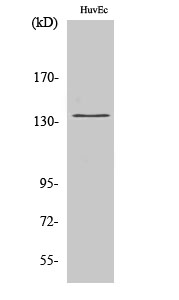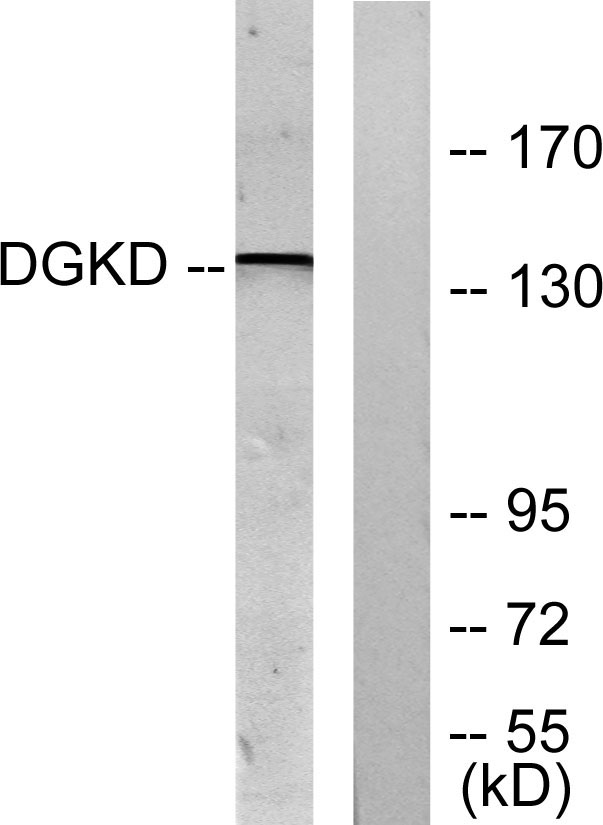DGK-δ Polyclonal Antibody
- Catalog No.:YT1333
- Applications:WB;IHC;IF;ELISA
- Reactivity:Human;Mouse
- Target:
- DGK-δ
- Fields:
- >>Glycerolipid metabolism;>>Glycerophospholipid metabolism;>>Metabolic pathways;>>Phosphatidylinositol signaling system;>>Phospholipase D signaling pathway;>>Choline metabolism in cancer
- Gene Name:
- DGKD
- Protein Name:
- Diacylglycerol kinase delta
- Human Gene Id:
- 8527
- Human Swiss Prot No:
- Q16760
- Immunogen:
- The antiserum was produced against synthesized peptide derived from human DGKD. AA range:41-90
- Specificity:
- DGK-δ Polyclonal Antibody detects endogenous levels of DGK-δ protein.
- Formulation:
- Liquid in PBS containing 50% glycerol, 0.5% BSA and 0.02% sodium azide.
- Source:
- Polyclonal, Rabbit,IgG
- Dilution:
- WB 1:500 - 1:2000. IHC 1:100 - 1:300. IF 1:200 - 1:1000. ELISA: 1:20000. Not yet tested in other applications.
- Purification:
- The antibody was affinity-purified from rabbit antiserum by affinity-chromatography using epitope-specific immunogen.
- Concentration:
- 1 mg/ml
- Storage Stability:
- -15°C to -25°C/1 year(Do not lower than -25°C)
- Other Name:
- DGKD;KIAA0145;Diacylglycerol kinase delta;DAG kinase delta;130 kDa diacylglycerol kinase;Diglyceride kinase delta;DGK-delta
- Observed Band(KD):
- 135kD
- Background:
- This gene encodes a cytoplasmic enzyme that phosphorylates diacylglycerol to produce phosphatidic acid. Diacylglycerol and phosphatidic acid are two lipids that act as second messengers in signaling cascades. Their cellular concentrations are regulated by the encoded protein, and so it is thought to play an important role in cellular signal transduction. Alternative splicing results in two transcript variants encoding different isoforms. [provided by RefSeq, Jul 2008],
- Function:
- catalytic activity:ATP + 1,2-diacylglycerol = ADP + 1,2-diacyl-sn-glycerol 3-phosphate.,enzyme regulation:Partially inhibited by phosphatidylserine.,function:May function as signaling molecule. Isoform 2 may be involved in cell growth and tumorigenesis.,PTM:Isoform 1 H domain is phosphorylated.,similarity:Belongs to the eukaryotic diacylglycerol kinase family.,similarity:Contains 1 DAGKc domain.,similarity:Contains 1 PH domain.,similarity:Contains 1 SAM (sterile alpha motif) domain.,similarity:Contains 2 phorbol-ester/DAG-type zinc fingers.,subunit:The two isoforms are able to form homo- and hetero-oligomer structures (at least tetramers).,tissue specificity:Isoform 2 is ubiquitously expressed also in tumor tissues. Isoform 1 is expressed in ovary, spleen and some tumor-derived cells.,
- Subcellular Location:
- Membrane, clathrin-coated pit . Cytoplasm .; [Isoform 1]: Cell membrane ; Peripheral membrane protein . Cytoplasm . Isoform 1 translocation from cytoplasm to the plasma membrane is induced by phorbol esters (PubMed:12200442). Phorbol esters induce the conversion into the monomeric form which can translocate to the plasma membrane (PubMed:12084710). .
- Expression:
- [Isoform 2]: Widely expressed. ; [Isoform 1]: Only detected in ovary, and to a lesser extent in spleen.
- June 19-2018
- WESTERN IMMUNOBLOTTING PROTOCOL
- June 19-2018
- IMMUNOHISTOCHEMISTRY-PARAFFIN PROTOCOL
- June 19-2018
- IMMUNOFLUORESCENCE PROTOCOL
- September 08-2020
- FLOW-CYTOMEYRT-PROTOCOL
- May 20-2022
- Cell-Based ELISA│解您多样本WB检测之困扰
- July 13-2018
- CELL-BASED-ELISA-PROTOCOL-FOR-ACETYL-PROTEIN
- July 13-2018
- CELL-BASED-ELISA-PROTOCOL-FOR-PHOSPHO-PROTEIN
- July 13-2018
- Antibody-FAQs
- Products Images

- Western Blot analysis of various cells using DGK-δ Polyclonal Antibody

- Western blot analysis of lysates from HUVEC cells, using DGKD Antibody. The lane on the right is blocked with the synthesized peptide.



